One topic has garnered a lot more attention than usual with students during our Natural Disasters workshops….Volcanoes! Mt. Kilauea, one of the volcanoes that makes up the Hawaiian Islands has been all over the news during the past month, and almost everyone knows about it. Why not jump on the bandwagon and use this opportunity to expand our volcano knowledge with our students? Try a volcano experiment from our >100 Free Experiments section in the classroom or at home!
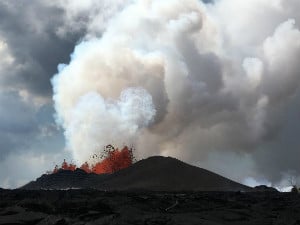
|A fountain of lava. (Source: U.S. Geological Survey)
Kilauea has actually been continuously erupting since 1983, though recent eruptions have forced many to evacuate the area. It all started May 3, when earthquakes, volcanic gasses and fountains of lava descended on the Puna district. Earthquakes and volcanic activity often go hand-in-hand because they are both related to tectonic plates, so it makes sense that since then there has been more than 10,000 earthquakes in the area. My favourite analogy of volcanic eruptions involves a delicious meat pie: If you put pressure on the pastry on top, the gravy will ooze out of weak points in the pastry! Perhaps at the edges, or sometimes there’s a crack or a hole in the middle.
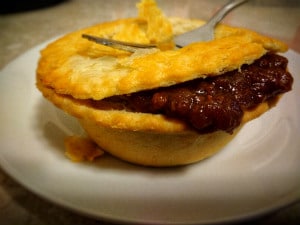
Geology demos with my afternoon snack!
Reading reports of the event, I learnt quite a few things! Here are ones that I found particularly interesting:
Volcanic Explosivity Index (VEI)
Exactly what it sounds like: a measure of how explosive a volcanic eruption is! The scale is relative, and ranges from 0 to 8; 0 being eruptions that are not explosive, so not a lot of stuff or tephra ejected, and 8 representing mega-colossal explosive eruptions (what an epic description!). There hasn’t been a volcanic eruption of VEI 8 magnitude for tens of thousands of years. The most explosive and recent eruption in recorded human history is that of Mt. Tambora, Indonesia in 1815, which was rated VEI 7. The eruption produced so much ash, it lowered the global temperature and the following year was aptly named “The Year Without Summer”! Kilauea on the other hand, has only has VEI 0-2 eruptions over the past 200 years. But these “gentle” eruptions can still cause a lot of damage, since they are close to tourist attractions and residential areas.
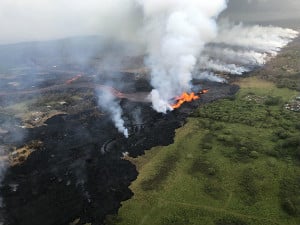
Aerial view of the lava flow. (Source: U.S. Geological Survey)
Lava is really heavy
Lava may be liquid, but it is still made of rock. So it shouldn’t be surprising that it can do more damage than just with its heat! In this report, lava splatters managed to break someone’s leg when it struck. Apparently, lava splatters “can weigh as much as a refrigerator”!
Acid rain
Breathing in noxious volcanic gasses emitted through the eruption, such as sulfur dioxide, can be pretty deadly. But these gasses can also turn rainwater acidic. Even though it’s not harmful to humans if it gets on our skin or eyes, it could affect pH levels of soils and therefore the growth of certain trees and plants. Metals on roofs or cars may also react with the weakly acidic rain, as well as statues or monuments if they are made of materials such as limestone.
New land forming
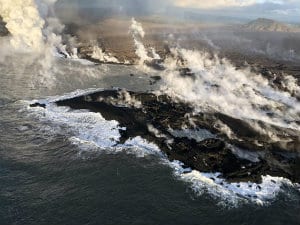
New land and a new coastline! (Source: U.S. Geological Survey)
I think it’s fascinating that the lava flow has formed new peninsula! All the cooled lava that flowed into the ocean have solidified and formed new land masses around the eruption site. Much of the land around that area was formed that way over many millennia.
It’s raining gems!
Friends of mine live in Hawaii, right next to the area impacted by the most recent lava flows. In the midst of the destruction nearby & stress of the unknown, they woke up to this – tiny pieces of olivine all over the ground. It is literally raining gems. Nature is truly amazing. pic.twitter.com/inJWxOp66t
— Erin Jordan (@ErinJordan_WX) June 11, 2018
How cool is that?! The latest phenomenon observed at Kilauea are the appearance of these green crystals known as olivine, a mineral composed of magnesium iron silicate. It’s pretty common, and you may have seen it as a gemstone called peridot. These wee beauties are being carried by the magma or lava and as it shoots up high into the air or encounters water from the ocean, the rapid cooling causes the lava to break apart and ejecting olivine pieces.
Happy teaching,
Jaqueline Kao
Follow the link below to make your own volcano!
Or book in Natural Disasters Workshop!
NEW Primary science teaching book!
“Be Amazing! How to teach science, the way primary kids love”

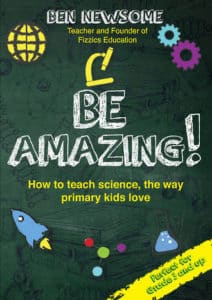

























Comments